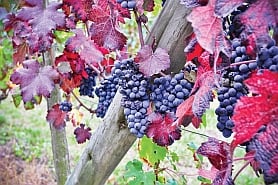The King of wines and the Wine of Kings — that’s what they call Barolo. The unpretentious village of Barolo in Piedmont has a population of 750 souls and its very own castle; but as a wine zone, Barolo stretches over 4,200 acres of calcareous-clay soils — three times the vineyard surface of neighbouring Barbaresco. Both wines are made with the same Nebbiolo grape. Barbaresco, because of its lighter character, is known as the “Q ueen of Wines.”
Some statistics: 13 million bottles of Barolo are produced annually by 350 producers, and that number rises to 500 if you include the ones that merely buy the wine and then bottle it under their own label. And as you might expect, since this is Italy, the wine has a contemporary history ready-made for Hollywood.
If Catherine of Medici’s chefs taught the French how to cook, then the French returned the favour by teaching the Piemontese of Italy how to transform Barolo into a dry wine.
In 1840 the ruling House of Savoy called in a French oenologist named Louis Oudart to turn Barolo from a sweet wine into something resembling red Burgundy. Although there are bottles extant bearing the name Barolo dated 1876, it wasn’t until 1966 that the Barolo appellation was given legal status.
This was a decade or so before things began to stir in the Barolo region. A revolution was in the making. The young generation began to question their fathers’ traditional winemaking techniques, which had been handed down for generations. The old guard made wine in large Slavonian oak botti with a capacity of 5,000 to 6,000 litres, macerating the skins and stalks of the Nebbiolo grapes with the juice for weeks during fermentation. The result was a highly tannic wine that took 25 years or more to become drinkable.
In the early 1980s, a group of young Turks (young Italian turks, in this case) led by Elio Altare, Domenico Clerico, Luciano Sandrone, Renato Corino and Enrico Scavino changed the game. They conducted green harvests (dropping grapes in August to concentrate flavour in the remaining bunches) and instead of long maceration in large barrels, they opted for a week or less skin contact and aged their wines in 225-litre French barriques.
This modern style, which could mature within five or six years, was much more consumer-friendly. But it caused a war in Barolo that split families apart. For the older generation, dropping fruit – the gift of God – was a blasphemy; its practitioners, heretics.
Perhaps the revolution in Piedmont started even earlier and more quietly — in the neighbouring Barbaresco region. In the late 1970s, when Angelo Gaja pulled out a Nebbiolo vineyard and replanted it with Cabernet Sauvignon, his father Giovanni exclaimed, in the local dialect, “Darmagi” (“what a pity”). And that’s what Gaja called his Cabernet Sauvignon 1982: Darmagi.
But the reaction to innovation was far from even tempered in Barolo. A war erupted between the traditionalists and the innovators. The young Elio Altare, passionate about the new style of winemaking, took a chainsaw down to the cellar of his father’s winery and made firewood of the large botti, in which his father made wine. The old man threw him out of the house and disinherited him.
These and other anecdotes are told in a 2014 documentary entitled Barolo Boys – The Story of A Revolution. The Barolo Boys, 14 of them plus one woman winemaker, Chiara Boschis, toured the United States by bus at the request of their importing agent, Marco de Grazia, who was dubbed “disgrazia” by some traditional Barolo winemakers. This American tour lit the fuse for the explosive popularity of the new style of Barolo in the United States and brought new wealth to the Langhe region of Piedmont.
In 2009, one of my New York-based wine colleagues, Ed McCarthy, wrote in his Winereviewonline.com blog, “… barrique-aged Barolos – especially in ripe vintages such as 1990, 1997, and 2000 – tasted a lot like the California Cabernets that American consumers were accustomed to drinking. From about the 1985 vintage on up to 2000, modern-style Barolos and Barbarescos and wines which combined aspects of modern and traditional style were more popular, at least in the U.S., than traditional Barolos — except for Barolo purists, such as yours truly and a handful of other eccentrics.”
McCarthy goes on to write that, as the 20th century came to a close, Barolo drinkers in the United States “came of age” and began to search out the traditional Barolo producers who made the wine the way their grandfathers made it — wines built to last for a generation.
On a recent visit to Barolo I found that many of the producers who espoused the 225-litre barrique are now going back to 500-litre casks and the larger botti to ferment and age their wines. What goes around comes around.
So if you’re looking for the kind of wines you can lay down for 30 years or so, here are some traditional Barolo producers to seek out: Burlotto, Cavallotto, Cappellano, Colla, Elvio Cogno, Giacomo Conterno, Bruno Giacosa, Marcarini, Bartolo Mascarello, Giuseppe Mascarello, Francesco Rinaldi, Giuseppe Rinaldi, Poderi Brovia and Luigi Pira. Other fine traditional Barolo producers include Giacomo Borgogno, Oddero and Massolino.





